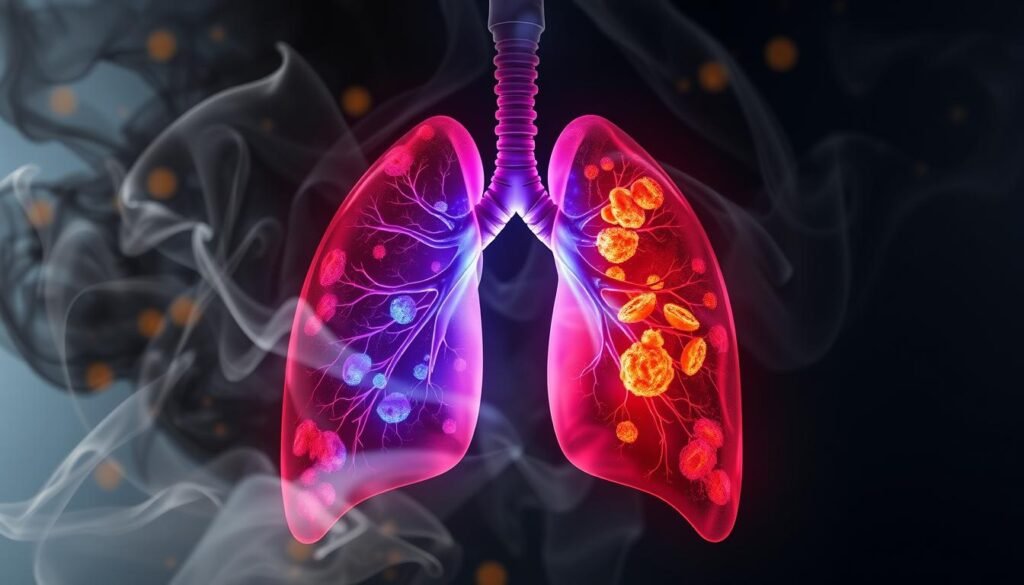Did you know almost all lung cancer deaths in the U.S. are due to smoking? A shocking 80% to 90% of them, to be exact. This fact shows the strong link between smoking and this deadly disease. It shows us the big impact tobacco has on people and society. It’s vital to understand how smoking leads to lung cancer to prevent it.
Tobacco smoke is a dangerous mix of over 7,000 chemicals. Out of these, 70 are known to cause cancer. Smokers are 15 to 30 times more likely to get lung cancer than non-smokers. The risk goes up the more and longer you smoke. But, there’s good news. If you stop smoking, you lower your chances of getting lung cancer. Yet, even those who quit smoking still face a higher risk than people who never smoked.
Key Takeaways
- 80% to 90% of lung cancer deaths in the U.S. are linked to cigarette smoking.
- Smokers face 15 to 30 times greater risks of developing lung cancer than non-smokers.
- Over 7,000 chemicals in tobacco smoke contribute to its carcinogenic properties.
- Even light smoking significantly increases the risk of lung cancer.
- Quitting smoking lowers lung cancer risk but former smokers remain at higher risk.
The Link Between Smoking and Lung Cancer
Smoking is the main cause of lung cancer, the top cancer killer worldwide. Cigarettes contain many substances that can cause cancer. These substances harm the lungs over time. This damage can lead to mutations and cancer in lung tissue. It’s vital to know about smoking risks and their impact on lung health.
Small cell lung cancer mainly affects heavy smokers. Lung cancer is split into small cell and non-small cell types. These cancers cause issues like breathing problems, constant coughing, and blood in sputum.
But smoking isn’t the only danger. Secondhand smoke, radon gas, and workplace toxins can also cause lung cancer. It’s wrong to think only smokers get lung cancer. Non-smokers can get it too. In fact, it’s the seventh most common cancer among them worldwide.
To lower lung cancer risks, don’t smoke or quit if you do. Stay away from secondhand smoke. Test for radon in your home. For more info on smoking and lung cancer, check this resource. Knowing these facts can increase awareness and support for those fighting lung cancer.
Key Statistics on Smoking and Lung Cancer
Smoking causes about 80% of lung cancer deaths in the U.S., equaling almost 160,000 deaths per year. This shows the big impact smoking has on health. Even though smoking is a main cause, 12% of lung cancer cases occur in people who have never smoked.
Research on more than 129,000 lung cancer cases from 2011 to 2016 shows who gets this disease. Among those who never smoked, 16% are women and 10% are men. Also, 28% of women and 19% of men diagnosed are between 20 and 49 years old in this group.
Adenocarcinoma, a type of non-small cell lung cancer, is common in “never smokers.” This means we need to study more about lung cancer causes beyond just smoking. This includes genetics and the environment.
Among those who have ever smoked, 90% of lung cancer patients are men. About half are aged 20 to 64 who are still smoking.
Lung cancer is more common in Black smokers than white or Hispanic smokers. This shows we need to help diverse groups to fight smoking risks.
Stopping smoking is crucial in preventing lung cancer. It greatly lowers the risk and improves overall health. Knowing these facts helps in raising awareness and reducing smoking.

How Does Smoking Cause Lung Cancer
When we look into how smoking causes lung cancer, we find a complex connection. This link is due to the cancer-causing chemicals in cigarettes. These substances play a big role in the dangers of smoking and its health effects.
Cancer-Causing Chemicals in Cigarettes
Cigarettes pack a punch with over 60 known carcinogens. These include benzene, formaldehyde, and polycyclic aromatic hydrocarbons. They damage lung tissues and set the stage for cancer. Over time, these chemicals can cause DNA changes, turning normal cells into cancerous ones. With every cigarette, smokers are exposed to 1.4 to 2.2 milligrams of these dangerous substances.
The Role of Tar and Carcinogens
Tar in cigarette smoke is a big problem. It helps harmful chemicals enter the lungs and causes inflammation. This inflammation, combined with the chemicals, increases cancer risk. The ongoing exposure to these substances severely damages lung health over time.

| Cancer-Causing Chemicals | Health Effect |
|---|---|
| Benzene | Linked to blood disorders and increased cancer risk |
| Formaldehyde | Causes irritation to respiratory tract and is a known carcinogen |
| Polycyclic Aromatic Hydrocarbons (PAHs) | Associated with lung, skin, and bladder cancers |
| N-nitrosamines | Strongly linked to various cancers, including lung cancer |
Impact of Secondhand Smoke on Lung Cancer Risk
Secondhand smoke poses serious health threats, especially regarding lung cancer. Those who don’t smoke but are around secondhand smoke face a higher risk of getting lung cancer. Knowing about these dangers can help us spread awareness and push for actions to prevent it.
Dangers of Secondhand Smoke
Secondhand smoke contains over 7,000 chemicals, with 70 known to cause cancer. Adults breathing in this smoke take in the same harmful substances as smokers do. This can damage cells and may start cancer. The more they’re exposed, the higher their risk of lung cancer. For example, non-smokers exposed to secondhand smoke have a 20% to 30% higher risk of lung cancer. This problem affects not only individuals but also their families.
Statistics on Secondhand Smoke Exposure
Every year, secondhand smoke causes over 7,300 lung cancer deaths in non-smoking U.S. adults. In total, this toxic smoke causes more than 19,000 deaths annually. Kids also face serious health issues from it, like respiratory infections and worsened asthma. The cost of health problems from secondhand smoke was $7.2 billion in lost productivity in 2017.
| Health Impact | Statistics |
|---|---|
| Increased Lung Cancer Risk | 20%-30% for non-smokers |
| Annual Lung Cancer Deaths (Non-Smokers) | 7,300+ deaths |
| Annual Deaths from Secondhand Smoke | 19,000+ deaths |
| Economic Loss from Secondhand Smoke | $7.2 billion (2017) |

Other Risk Factors Associated with Lung Cancer
Smoking is a well-known cause of lung cancer, but it’s not the only one. There are other factors that also play a big role. Knowing about these can help us prevent lung cancer better and spread awareness.
Radon Exposure
Radon is the second leading cause of lung cancer in the U.S. This harmful gas comes from natural uranium decay in the ground. It’s tricky because you can’t see or smell it.
It often gathers in places like basements, where air doesn’t move much. About one in 15 U.S. homes has high radon levels. If you smoke and live in a house with radon, your risk of lung cancer goes up a lot.
Workplace Carcinogens
Being around certain chemicals at work can also raise your lung cancer risk. Things like asbestos, arsenic, cadmium, and diesel exhaust are really harmful. People who work in construction or manufacturing are more likely to come into contact with these substances.
If you smoke and are also exposed to these workplace dangers, your chance of getting lung cancer is much higher. It’s a big health issue for workers in these industries.
| Risk Factor | Details | Population at Risk |
|---|---|---|
| Radon Exposure | Second-leading cause of lung cancer; accumulates in homes, especially in basements. | Estimated 1 in 15 homes in the U.S. |
| Asbestos | Linked to higher lung cancer rates, particularly among construction workers. | Construction and manufacturing workers. |
| Arsenic | Exposure through certain industrial processes and contaminated water. | Workers in affected industries and communities. |
| Diesel Exhaust | Increases lung cancer risk for professional drivers and mechanics. | Individuals regularly exposed at their jobs. |
Understanding Smoking Addiction
Nicotine in tobacco sparks addiction by offering quick pleasure and relaxation. This feeling, though short-living, leads to dependence for many. The cycle of seeking stress relief through smoking makes quitting tough. This is how smoking addiction traps individuals.
Understanding how addiction operates helps in quitting attempts. Public health efforts strive to educate about nicotine’s addictive traits. They tackle the mental reasons driving tobacco use. Knowing why people smoke, like stress or peer pressure, is key to stop smoking.
The impact of smoking addiction stretches beyond the smoker. It imposes health care costs and productivity losses on families and society. When someone quits smoking, it’s a win for both the individual and the community. It cuts health care costs and improves public health.
- Nicotine dependence starts a cycle where stress relief causes more smoking.
- Health campaigns teach the quit challenges and perks of not smoking.
- Quitting smoking is often a process with several tries needed.
Studies show that counseling and FDA-approved drugs greatly aid quitting. Realizing the gains of quitting smoking goes beyond health. It betters overall happiness and life quality. By tackling the main issues of smoking addiction, we can support those wanting to quit tobacco.
Benefits of Quitting Smoking
Quitting smoking leads to better health right away. In just 20 minutes, your heart rate and blood pressure drop. The longer you go without smoking, the better you feel. Quitting not only improves health but also lowers the risk of serious diseases like lung cancer.
Health Improvements After Quitting
Quitting smoking makes many parts of life better. People who quit enjoy better taste and smell. They also get more physically fit and look better. One big benefit is a huge drop in the chance of getting lung cancer. This chance goes down the longer they don’t smoke. Quitting before lung cancer diagnosis improves survival rates.
Statistics on Lung Cancer Risk Reduction
Stopping smoking cuts lung cancer risk sharply. About 40% of lung cancer happens in people who’ve quit for 15 years. Quitting means lower death rates from lung cancer. For example, those who quit after finding they have lung cancer live about 22 months longer. After three years, 75% of quitters versus 66% of smokers are still alive. Quitting also benefits from programs like the Cancer Center Cessation Initiative (C3I). This program helps cancer patients quit. For more on quitting benefits, check out this resource.
| Time Since Quitting | Risk of Lung Cancer |
|---|---|
| 0-5 years | 12.12 times greater than never smokers |
| 5-10 years | 11.77 times greater than never smokers |
| 10-15 years | 7.81 times greater than never smokers |
| 15-25 years | 5.88 times greater than never smokers |
| Over 25 years | 3.85 times greater than never smokers |
Lung Cancer Prevention Strategies
Lung cancer prevention is key to reducing diagnosis rates. A multifaceted approach can greatly lower the risk of this disease. It involves healthy lifestyle choices and knowing your health risks.
Healthy Lifestyle Choices
Choosing a healthy lifestyle is crucial for prevention. Here are important choices to make:
- Avoiding tobacco in all forms is the best way to cut lung cancer risk.
- Minimizing exposure to secondhand smoke helps protect non-smokers.
- Eating lots of fruits and vegetables boosts health and may help prevent lung cancer.
- Regular physical activity might lower your cancer risk.
- Limiting exposure to radon is important. Seal your basement and make sure it’s well-ventilated.
Regular Screening and Awareness
Knowing your health history is important for prevention. Regular screenings help catch cancer early, especially for those at high risk:
- Following the lung cancer screening guidelines boosts survival rates.
- Annual low-dose CT scans are advised for those 55 to 80 who smoked a lot.
- Public health campaigns inform people about how to prevent lung cancer.
Conclusion
It’s vital to understand how smoking leads to lung cancer. This knowledge is key for our health and the community’s wellness. Knowing the link between smoking and lung cancer is the first step. Teaching people about the risks of tobacco, including secondhand smoke, is crucial for prevention.
Every year, lung cancer takes about 1.5 million lives worldwide. Shockingly, 95% of these deaths could be avoided. This highlights the need for strong actions to reduce smoking. Such steps can greatly improve health in communities. For heavy smokers, the risk of lung cancer death is especially high.
The fight against smoking isn’t over. Public health efforts must keep up as smoking patterns change. We need to keep pushing lung cancer prevention and help smokers quit. Doing this can save future generations from tobacco’s harmful effects. Let’s commit to spreading awareness and providing education for a healthier future.